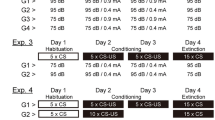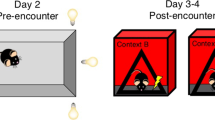Abstract
This article describes the results of recent studies that examine the effects, in rats, of defeat by a dominant conspecific on subsequent defensive responses and hypoalgesia. In Experiment 1, male subjects were exposed to either aggressive (alpha) or nonaggressive conspecific colonies and tested 24 hr later, with or without alpha-colony odors, for freezing and burying of a wall prod that had been the source of a single electric shock. Although prior exposure to defeat and the presence of alpha-colony odors during testing had no effects, per se, the combination of these factors significantly suppressed prod burying and increased freezing. In Experiment 2, a 12-hr exposure session to the alpha-colony odors, for previously defeated intruders, resulted in the extinction of the fear-mediated suppressions in burying and increments in freezing during later prod-shock tests with alpha-colony odors present. In Experiment 3, male rats were either defeated as colony intruders by alpha conspecifics or had no defeat experience, and 24 hr later they were given a paw injection of formalin prior to observational tests with or without alpha-colony odors. The combination of defeat and tests with these odors produced conditioned hypoalgesia (i.e., a suppression in paw licking) and freezing. In Experiment 4, an injection of naltrexone prior to a defeat session increased freezing during defeat and during formalin testing 24 hr later, whereas injecting naltrexone prior to testing did not affect freezing but significantly reduced conditioned hypoalgesia. In Experiment 5, a 12-hr pretest exposure session to alpha-colony odors extinguished this conditioned hypoalgesic response for previously defeated rats. These fear-induced alterations in defensive behavior and pain sensitivity are discussed in terms of associative, opioid/nonopioid, and adaptive evolutionary processes.
Similar content being viewed by others
References
AMIR, S., & AMIT, Z. (1978). Endogenous opioid ligands may mediate stress-induced changes in affective properties of pain-related behaviour in rats. Life Sciences, 23, 1143–1152.
AMIR, S., & AMIT, Z. (1979). The pituitary gland mediated acute and chronic pain responsiveness in stressed and non-stressed rats. Life Sciences, 24, 439–448.
AMIR, Z., & GALINA, H. (1986). Stress-induced analgesia: Adaptive pain suppression. Physiological Reviews, 66, 1091–1119.
BARNETT, S. A. (1958). An analysis of social behaviour in wild rats. Proceedings of the Zoological Society of London, 130, 107–152.
BAUM, M. (1970). Extinction of avoidance responding through response prevention (flooding). Psychological Bulletin, 74, 276–284.
BLANCHARD, R. J., & BLANCHARD, D. C. (1977). Aggressive behavior in the rat. Behavioral Biology 21, 197–224.
BLANCHARD, R. J., & BLANCHARD, D. C. (1981). The organization and modelling of aggressive behavior. In P. F. Brain & D. Benton (Eds.), The biology of aggression (pp. 529–561). Alphen aan den Rijn: Noordhoof/Sijthoff Press.
BLANCHARD, R. J., BLANCHAD, D. C., & HORI, K. (1989). An ethoexperimental approach to the study of defense. In R. J. Blanchard, P. F. Brain, & D. C. Blanchard, & S. Parmigiani (Eds.), Ethoexperimental approaches to the study of behavior (pp. 114–136). Dordrecht: Martinus Nijhoff.
BOLLES, R. C., & FANSELOW, M. S. (1980). A perceptual-defensive-recuperative model of fear and pain. Behavioral and Brain Sciences, 3, 291–323.
FANSELOW, M. S. (1984). Shock-induced analgesia on the formalin test: Effects of shock severity, naloxone, hypophysectomy, and associative variables. Behavioral Neuroscience, 98, 79–95.
FANSELOW, M. S. (1985). Odors released by stressed rats produce opioid analgesia in unstressed rats. Behavioral Neuroscience, 99, 589–592.
FANSELOW, M. S. (1986). Conditioned fear-induced opiate analgesia: A competing motivational state theory of stress analgesia. In D. D. Kelley (Ed.), Annals of the New York Academy of Sciences (Vol. 476, pp. 40–54).
FANSELOW, M. S., & BAACKES, M. P. (1982). Conditioned fear-induced opiate analgesia on the formalin test: Evidence for two aversive motivational systems. Learning and Motivation, 13, 200–221.
FANSELOW, M. S., & BOLLES, R. C. (1979). Naloxone and shock-elicited freezing in the rat. Journal of Comparative and Physiological Psychology, 94, 736–744.
FANSELOW, M. S., & HELMSTETTER, F. J. (1988). Conditioned analgesia, defensive freezing, and benzodiazepines. Behavioral Neuroscience, 102, 233–243.
FANSELOW, M. S., & LESTER, L. S. (1988). A functional behavioristic approach to aversively motivated behavior: Predatory imminence as a determinant of the topography of defensive behavior. In R. C. Bolies & M. D. Beecher (Eds.), Evolution and learning (pp. 185–212). Hillsdale, NJ: Erlbaum.
FANSELOW, M. S., & SIGMUNDI, R. A. (1986). Species-specific danger signals, endogenous opioid analgesia, and defensive behavior. Journal of Experimental Psychology: Animal Behavior Processes, 12, 301–309.
FANSELOW, M. S., SIGMUNDI, R. A., & WILLIAMS, J. L. (1987). Response selection and hierarchical organization of species-specific defensive reactions: The relationship between freezing, flight, and defensive burying. The Psychological Record, 37, 381–386.
FLANNELLY, K. J., FLANNELLY, L., & BLANCHARD, R. J. (1984). Adult experience and the expression of aggression: A comparative analysis. In K. J. Flannelly, R. J. Blanchard, & D. C. Blanchard (Eds.), Biological perspectives on aggression (pp. 207–259). New York: Alan Liss.
HELMSTETTER, F. J., & FANSELOW, M. S. (1987). Effects of naltrexone on learning and performance of conditional fear-induced freezing and opioid analgesia. Physiology & Behavior, 39, 501–505.
LESTER, L. S., & FANSELOW, M. A. (1985). Exposure to a cat produces opioid analgesia in rats. Behavioral Neuroscience, 99, 756–759.
LEVIS, D. J. (1989). The case for a return to two-factor theory of avoidance: The failure of non-fear interpretations. In S. B. Klein & R. R. Mowrer (Eds.), Contemporary learning theories: Pavlovian conditioning and the status of traditional learning theory (pp. 227–278). Hillsdale, NJ: Erlbaum.
MACLENNAN, A. J., JACKSON, R. L., & MAIER, S. F. (1980). Conditioned analgesia in the rat. Bulletin of the Psychonomic Society, 15, 387–390.
MAIER, S. F. (1986). Stressor controllability and stress-induced analgesia. In D. D. Kelley (Ed.), Annals of the New York Academy of Sciences (Vol. 467, pp. 55–71).
MAIER, S. F. (1989). Determinants of the nature of environmentally induced hypoalgesia. Behavioral Neuroscience, 103, 131–143.
MAIER, S. F., DAVIES, S., GRAU, J. W., JACKSON, R. L., MORRISON, D., MOYE, T., MADDEN, J., & BARCHAS, J. D. (1980). Opiate antagonists and the long-term analgesia reaction induced by inescapable shock. Journal of Comparative and Physiological Psychology, 94, 1172–1184.
MAIER, S. F., DRUGAN, R., GRAU, J. W., HYSON, R., MACLENNAN, A. J., MOYE, T., MADDEN, J., & BARCHAS, J. D. (1983). Learned helplessness, pain inhibition and the endogenous opiates. In M. D. Zeiler & P. Harzern (Eds.), Advances in animal behavior (Vol. 3, pp. 275–323). New York: Wiley & Sons.
MAIER, S. F., & SELIGMAN, M. E. P. (1976). Learned helplessness: Theory and evidence. Journal of Experimental Psychology: General, 105, 3–46.
MEEK, L. R., GIBSON, B. M., & KEMBLE, E. D. (1989). Effects of fluprazine hydrochloride on reactivity to a nonconspecific intruder. The Psychological Record, 39, 203–210.
MICZEK, K. A., THOMPSON, M. L., & SHUSTER, L. (1982). Opioid-like analgesia in defeated mice. Science, 215, 1520–1522.
MICZEK, K. A., THOMPSON, M. L., & SHUSTER, L. (1986). Analgesia following defeat in an aggressive encounter: Development of tolerance and changes in opioid receptors. In D. D. Kelly (Ed.), Annals of the New York Academy of Sciences (Vol. 467, pp. 14–29).
MINEKA, S. (1979). The role of fear in theories of avoidance learning, flooding, and extinction. Psychological Bulletin, 86, 985–1010.
PINEL, J. P. J., & TREIT, D. (1978). Burying as a defensive response in rats. Journal of Comparative & Physiological Psychology, 92, 708–712.
PINEL, J. P. J., & TREIT, D. (1981). The conditioned defensive burying paradigm and behavioral neuroscience. In T. E. Robinson (Ed.), Behavioral contributions to brain research (pp. 212–234). Oxford, England: Oxford University Press.
RODGERS, R. J. (1989). Ethoexperimental analysis of “stress” analgesia. In R. J. Blanchard, P. F. Brain, D. C. Blanchard, & S. Parmigiani, Ethoexperimental approaches to the study of behavior (pp. 214–228). Dordrecht: Martinus Nijhoff.
RODGERS, HENDRIE, C. A. (1982). Agonistic behaviour in rats: Evidence for non-involvement of opioid mechanisms. Physiology & Behavior, 29, 85–90.
RODGERS, R. J., & RANDALL, J. I. (1985). Social conflict analgesia: Studies on naloxone antagonism and morphine cross-tolerance in male DBA/2 mice. Pharmacology, Biochemistry, & Behavior, 23, 883–887.
RODGERS, R. J., & Randall, J. I. (1986a). Acute non-opioid analgesia in defeated male mice. Physiology & Behavior, 36, 947–950.
RODGERS, R. J., & RANDALL, J. I. (1986b). Extended attack from a resident conspecific is critical to the development of long-lasting analgesia in male intruder mice. Physiology & Behavior, 38, 427–430.
RODGERS, R. J., & RANDALL, J. I. (1986c). Resident’s scent: A critical factor in acute analgesia reaction to defeat experience in male mice. Physiology & Behavior, 37, 317–322.
RODGERS, R. J., & RANDALL, J. I. (1987). Potent inhibition of non-opioid defeat analgesia in male mice by benzodiazepine antagonist Ro15-3505. Physiology & Behavior, 42, 461–464.
RODGERS, R. J., & RANDALL, J. I. (1988). Environmentally-induced analgesia: Situational factors, mechanisms and significance. In R. J. Rodgers & S. J. Cooper (Eds.), Endorphins, opiates, and behavioral processes (pp. 107–142). Chichester: J. Wiley.
WILLIAMS, J. L. (1982). Influence of shock controllability by dominant rats on subsequent attack and defense behaviors toward colony intruders. Animal Learning and Behavior, 10, 305–313.
WILLIAMS, J. L. (1984). Influence of postpartum shock controllability on subsequent maternal behavior in rats. Animal Learning & Behavior, 12, 209–216.
WILLIAMS, J. L. (1987a). Effects of shock controllability on alpha male aggression and defense, defeat of intruders, and defensive burying. The Psychological Record, 37, 369–380.
WILLIAMS, J. L. (1987b). Influence of conspecific stress odors and shock controllability on conditioned defensive burying. Animal Learning and Behavior, 15, 333–341.
WILLIAMS, J. L. (1989). Ethoexperimental analysis of stress, contextual odors, and defensive behaviors. In R. J. Blanchard, P. F. Brain, D. C. Blanchard, & S. Parmigiani, Ethoexperimental approaches to the study of behavior. (pp. 214–228). Dordrecht: Martinus Nijhoff.
WILLIAMS, J. L., JUST, J. M., & WORLAND, P. D. (1990). Effects of repeated defeat as a colony intruder on subsequent conditioned and sensitization hypoalgesic reactions and their reversibility by naltrexone. Manuscript submitted for publication.
WILLIAMS, J. L., & LIERLE, D. M. (1986). Effects of stress controllability, immunization, and therapy on the subsequent defeat of colony intruders. Animal Learning and Behavior, 14(3), 305–314.
WILLIAMS, J. L., & LIERLE, D. M. (1988). Effects of repeated defeat by a dominant conspecific on subsequent pain sensitivity, open-field activity, and escape learning. Animal Learning & Behavior, 16, 477–485.
WILLIAMS, J. L., ROGERS, A. G., & ADLER, A. P. (1990). Exposure to conspecific and predatory odors reduce subsequent fear reactions following prod shock. Animal Learning & Behavior, 18(4), 453–461.
WILLIAMS, J. L., & SCOTT, D. K. (1989). Influence of conspecific and predatory stressors and the associated odors on defensive burying and freezing. Animal Learning & Behavior, 17, 383–393.
WILLIAMS, J. L., WORLAND, P. D., & SMITH, M. G. (1990a). Defeat-induced hypoalgesia in the rat: Effects conditioned odors, naltrexone, and extinction. Journal of Experimental Psychology: Animal Behavioral Processes 16, 4 345–357.
WILLIAMS, J. L., WORLAND, P. D., & SMITH, M. G. (1990b). Effects of shock controllability and odors from shocked conspecifics on formalin-induced hypoalgesia. Manuscript submitted for publication.
WORLAND, P. D., JUST, J. M., & WILLIAMS, J. L. (1990). Effects of conspecific, predatory, and shock-induced stress, and their associated odors, on hypoalgesia and freezing: Conditioning versus sensitization. Manuscript submitted for publication.
Author information
Authors and Affiliations
Additional information
I acknowledge the invaluable assistance of Paul Worland, Marc Just, Melinda Smith, Amy Rogers, Allison Adler, and David Scott. This research was supported by USPHS Research Grant 1-RO1-MH43815-03 and endowment funds from the Samual B. Cummings Professorship in Psychology.
Rights and permissions
About this article
Cite this article
Williams, J.L. Conditioned Defensive Responses and Hypoalgesia in Rats Exposed to Defeat and Alpha-Colony Odors. Psychol Rec 41, 271–297 (1991). https://doi.org/10.1007/BF03395110
Published:
Issue Date:
DOI: https://doi.org/10.1007/BF03395110




